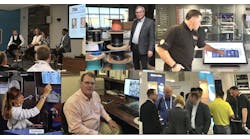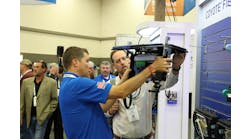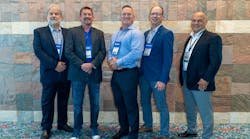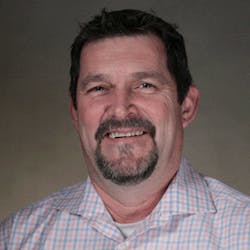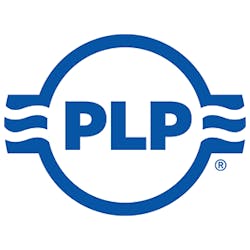Latest from Professional Development/Leadership
ISE EXPO 2021 Executive Roundtable Highlights
With Corning, Dura-Line, Hexatronic, PLP, And Vitruvi
This invitation-only event, held at ISE EXPO 2021, and moderated by Janice Oliva, President and Publisher of ISE magazine, brought these 5 leading vendors together for a content-rich discussion exploring industry challenges and opportunities for the future.
Roundtable Executives:
ISE: Share the 3 best practices you’ve learned in 2020-21 that you will use going forward.
Baker, Corning: I learned to become a better listener when talking to my customers. I tried to understand what I was hearing from my customers; to see what the true underlying needs might be, and to ask better questions that allow me to help them meet their targets.
While it is an important part of any project, the Day 1 Budget cannot be the #1 priority for any build. When the initial cost is the main driver for a project, then corners will be cut, intuition will be curbed, and the planning process for creating a connected future will begin to be trimmed down.
Assume that your original timeline will change.
Grimsley, Dura-Line:
1. Plan, plan, plan.
2. Listen to our customers (then go back to #1).
3. People have always been key and very important to our company. But unlike any other time in our industry’s history, now we need to invest even more in training, support, and well-being.
Blell, Hexatronic:
1. Subscribers will not wait 2-3 weeks for a broadband connection if one is available within 1-2 days — even if it’s not fiber. Build a fiber system with which you can light up your customer in the shortest time.
2. Plan for additional pathways for your feeder networks so you can scale with time without the need to place all the fiber in the ground on Day One.
3. Choose a system supply partner, not based only on component price, but on total system value and support levels including site support, training, and backed by system warranties.
Levac, PLP:
1. Don’t cut corners. Take the time to understand the end goals and the best way to achieve them. Then try to look beyond your current needs and technology and plan for additional devices, uses, and advancements.
2. When you think technology has advanced as much as it can, think again. Multicore fiber, advances in network slicing, and even manufacturing technologies continue to evolve and bring additional capabilities to the broadband field.
3. Listen and learn. Listen to your material suppliers and understand the limitations of raw materials, the sheer volume of orders, and delivery issues. There are a lot of happenings in the field of broadband with many resources to provide insight, understanding, and techniques, to developing and deploying the best network possible. Take your time making those critical decisions.
McIver, Vitruvi:
1. Start all planning and deployment with a digital, GIS-based design, that can be shared directly with build partners and, in so doing, can be used to enable automated/digital workflows during construction.
2. Record and collect build data as close to the source of the data as possible. Eliminate unnecessary hand-offs between multiple people and systems; record it accurately the first time, from the field.
3. Collaborate with contractors, subcontractors, and other build partners, on a single platform — much like other industries have collaborated across the value chain — to drive increased quality and efficiency.
ISE: How do we build and maintain a modern communications infrastructure to support a connected future?
Baker, Corning: The key to a connected future is making sure that the infrastructure’s backbone is built properly the first time. Only with a future- proofed fiber backbone and knowledgeable workers can our connected future properly flourish.
Grimsley, Dura-Line: The fiber you are installing today is not enough. No matter how much you are installing, we can almost guarantee with certainty that it’s not enough. Leverage detailed records of the networks: where cables are located and if there are any empty ducts along the route. Maintaining a modern network depends on accurate mapping.
Blell, Hexatronic: Regardless of the range of considerations that must be taken into account before deciding how to build a modern network, I am sure we can agree on some fundamentals:
1. Build it once.
2. Build it with fiber.
3. Ensure that your system design passes all homes and businesses within the service area, and that connections can be made quickly.
4. Contractors are selected based on efficiency and quality of workmanship.
5. Operations personnel are trained on all aspects of the system.
6. Monitor your system performance and customer satisfaction routinely, and address accordingly.
Levac, PLP: Understand that the products you select for your infrastructure must be adaptable. Technology is advancing at such a rapid pace; your deployment methodology must be scalable. Don’t settle. The longevity of your infrastructure depends on quality, both in the deployment and the products you select.
McIver, Vitruvi: Move towards digital record-keeping. Design, build, and record, all aspects of deployment digitally on a GIS-based platform.
ISE: Inefficiencies in construction contribute to an overall 30% increase in the cost of capital investments in utility infrastructure. Solving this one issue allows asset owners (and ultimately all rate payers) to lower CapEx by a significant margin, thereby increasing the size of the footprint that can be built. This helps stretch government grant dollars farther, frees up investment dollars for R&D and other supporting investments, etc.
What does it mean to future-proof your network, and how can you attempt to do it the right way?
Baker, Corning: As you develop your initial strategy for building a connected future, the incremental cost of upsizing the fiber sheath is minimal compared to the other pieces within the project. A strong strategy includes looking at all potential areas for growth out in the field: residences and businesses, known and possible upcoming developments, strategic placement of infrastructure access points — all in service of building your backbone once.
Grimsley, Dura-Line: The only thing we can predict about the future is that it will depend on connectivity. Having additional conduits or pathways installed is the answer to planning for the future. While you still can’t predict where the demand will take place, your network system design needs to be flexible to accommodate growth in every direction.
Blell, Hexatronic: Even with an all-fiber network, there are varying levels of future-proofing. PON vs. active systems, available optical power, available fibers and/or pathways to install additional fibers, must all be considered at the time of network design. Consider and evaluate microduct technology as a viable option for maximum system flexibility and scalability.
Levac, PLP: Fiber enables the network owner to scale and deliver higher speeds and lower latency. The products must have the capacity to scale up to add additional fiber for laterals while using the same equipment in the OSP.
McIver, Vitruvi: Collaborate on a digital platform with build partners. Share GIS and as-built data with your build and deployment partners. Don’t keep this data siloed; rather, collaborate up and down the value chain, ensuring that critical data captured during the build phase is available for all parts of the operation long into the future.
ISE: Is slicing network and automation being used now or in the near future? Can it help providers increase capacity?
Baker, Corning: Slicing and automation are both being used now, and allow for more specialized dedicated services and product offerings as well as better utilization of the network.
Blell, Hexatronic: Municipalities planning for future-proof smart city applications are designing multi-pathway fiber deployment which can easily be accessed at a wide range of access points. Point-to-point systems, and multi-carrier connectivity, seem to be preferred for such designs to maximize bandwidth and range of active devices used by different service providers.
Levac, PLP: With a strong fiber backbone, slicing becomes more possible since it is primarily a software-driven technology. The farther into the network fiber goes, the easier to slice the network end-to-end.
ISE: Which is coming first to a neighborhood near you: 5G or WiFi6?
Baker, Corning: This depends on the region where your project is being built. 5G and WiFi6 will be available to a majority of people in the near future, but at differing levels.
Grimsley, Dura-Line: In reality, both. The larger cities are moving to 5G and we are seeing a trend of rural areas looking at WiFi6. Both can, and do, work well together.
Blell, Hexatronic: It doesn’t matter; make sure you have bandwidth in place to support it.
Levac, PLP: From a cost perspective, WiFi6 would most likely come first; however, the 2 services complement each other, so having access to both would greatly benefit the end user. WiFi6 will be more widely available.
Biographies:
Kevin Baker, Market Development Manager, Corning
Kevin Baker is the Americas Market Development Manager for Corning. Kevin brings 25 years of experience from Verizon as a lead engineer for FTTx and fiber deployment, network planning and product selection, all utilized for the creation of proper strategies for engineering and network construction. Kevin currently works in a Market and Business Development role, focusing on the 4G densification and 5G builds, and aiding our customers in making holistic decisions towards their fiber and equipment deployments as well as proper utilization of their available assets to prepare their networks. Kevin has a bachelor’s degree in mathematics, and currently resides in Fort Worth, Texas, with his bride of 15 years, Vicki.
Corning is one of the world’s leading innovators in materials science. For more than 160 years, we have applied our unparalleled expertise in specialty glass, ceramics, and optical physics to develop products that have created new industries and transformed people’s lives. Our Optical Communications division brings fiber to the people, wherever they live. We deliver connectivity to every edge of the network, from optical fiber, cable, hardware and equipment to fully optimized solutions for high-speed communications networks. Visit us at www.corning.com/opcomm.
Twitter @CorningOpComm
LinkedIn: Corning Optical Communications
LinkedIn: Kevin Baker
Tim Grimsley, Vice President of Global Customer Engagement, Dura-Line
Tim Grimsley, Vice President, Global Customer Engagement, began his career with Dura-Line in 1995, serving in critical roles that lead to growth in Latin America, U.S. and Canada. In addition to building a Strategic Account Program, Sales and Marketing, Field Solutions Architect group, and R&D program, Tim developed next-generation MicroTechnology products. Prior to Dura-Line, Tim worked at NORTEL and United Telephone. He has an Engineering Degree from ITI and the University of South Florida.
Dura-Line, an ISO-9001 and TL 9000 rated manufacturer of HDPE conduits, is a leading global manufacturer and distributor of communication and energy infrastructure products and systems including conduit, cable-in-conduit, and accessories. We take pride in our US manufacturing capability and state-of-the-art quality products. Several advanced manufacturing techniques set us apart, including low friction SILICORE™ permanently lubricated lining and FuturePath MicroTechnology.
Leading the development of MicroTechnology, we offer FuturePath configurations for both outside plant, and plenum, riser and low smoke zero halogen (LSZH) for inside plant installations. Dura-Line’s products are designed to provide for protection and fast, safe installation of communication networks, and power cables for a wide variety of markets, including telecommunications, enterprise networking, energy, and transportation. Acquired by Orbia in 2014, Dura-Line has over 20 global manufacturing facilities in the US, Canada, India, Oman, and Europe. Visit us at www.duraline.com.
LinkedIn: Dura-Line
Beni Blell, Vice President of Sales, Hexatronic
Beni Blell, RCDD, is the Vice President of Sales for Hexatronic North America. He has over 25 years of experience in the Information Communications Technology (ICT) industry, mainly focusing on optical fiber technology. His diverse career has included roles in product development, product management, and business development. Prior to joining Hexatronic, Beni spent 16 years with Berk-Tek, a Nexans Company where he most recently led business development activities for Nexans Data Center Solutions. Beni can be reached at [email protected]
Hexatronic offers a wide selection of passive fiber system solutions and products for FTTH, metro, access, and transportation networks. Our complete end-to-end system solutions utilize blown fiber technology and include all components needed to build the entire cabling infrastructure. Our solutions deliver the lowest total cost of ownership along with the highest levels of system flexibility, scalability, and speed of installation.
Our systems are also designed to meet the needs of upgrading and extending the network. The payoff is life cycle cost control of the network. Based on the extensive experience from the companies within Hexatronic, we are able to offer one of the broadest fiber optic product portfolios. Hexatronic strives to strengthen our position as the leading player in connecting people to the global digital infrastructure, through continuous development of innovative solutions and products. Visit us at www.hexatronic.com.
Dan Levac, National Sales Manager, Communications Markets, Preformed Line Products
Dan Levac began his career in the telecommunications industry as a Cable Splicer with Bell Canada in 1980. After cutting his teeth in the splicing trade, Dan transitioned to a career with Preformed Line Products (PLP®) in 1990. He began his PLP career as a Field Service Representative where he was able to utilize his decade-long experience as a cable splicer to provide exceptional training, troubleshooting, and customer service to PLP’s end users. Dan was quickly promoted to Field Sales Representative in 1991 where he was responsible for sales and product support for the 5-state region of Indiana, Illinois, Michigan, Ohio, and Wisconsin. He was promoted to Western Regional Manager in 1998 and to National Sales Manager, Communications Markets in 2017 where he is responsible for implementing PLP’s national sales strategy. Dan also has extensive international sales experience, helping to grow PLP’s Communications market abroad. In addition to his impressive sales and product support career, Dan is also focused on developing new products for the communications industry and currently shares 3 patents for OSP products developed by PLP.
Preformed Line Products (PLP®) is a worldwide designer, manufacturer, and supplier, of high-quality products and systems used to construct and maintain overhead and underground networks for the communication and energy industries. The company’s communications segment is trusted to protect critical connections for telecommunications network operators, government agencies, and broadband service providers, among others. PLP offers innovative communications products and services, including the COYOTE® line of fiber optic closures, FIBERLIGN® hardware solutions, and comprehensive drone-based asset inspections.
Headquartered in Cleveland, Ohio, PLP was founded in 1947 and has since grown into a united global corporation that provides precision-engineered products and unparalleled service through its offices and manufacturing facilities in over 20 countries.
Twitter: @preformedcoLinkedIn: https://www.linkedin.com/company/preformed-line-productsBryan McIver, CEO, Vitruvi
Bryan McIver, CEO, oversees vision, strategy and investor relations at Vitruvi, the world’s first horizontal construction management platform that fully integrates GIS designs into the end-to-end project life cycle. Bryan brings a wealth of experience from previously overseeing a 400+ person engineering, construction, and procurement team, responsible for the deployment of $1B in local access, broadband fiber networks, passing more than 250K premises on an annual basis.
Career highlights include leading the project management team responsible for deploying the first private GPON network in North America, as well as designing and building one of Canada’s first, municipal-wide, brownfield, FTTx networks.
Developed by an industry team that has "lived the problem" of deploying complex network projects, Vitruvi Software is an innovative end-to-end telecom construction management platform that modernizes construction operations, drives cost savings, and increases accuracy in data reporting. Linking directly to network design, Vitruvi removes the barriers between engineering/construction data and workflows. By aggregating designs, documents, photos, schedules, as well as financial and construction production data, all project stakeholders can access a true single source-of-truth and maintain real-time visibility into build status. Vitruvi™ is available on desktop and on mobile Android and iOS devices. Discover more at www.vitruvisoftware.com.
- GIS-enabled construction management interface
- Links directly to network design, inventory, and financial systems
- Integrated cost and schedule
- Mobile field and production reporting
- As-built markups and redlines from mobile
- End-to-end workflows and task dependencies
- Multi-stakeholder collaboration in real time
- Open APIs with geoJSON capability
LinkedIn: https://www.linkedin.com/in/bryanmciver/
LinkedIn: https://wwwlinkedin.com/company/vitruvi-software

Janice Oliva | VP, Event Business Development, Endeavor Business Media
Janice Oliva is the VP, Event Business Development for Endeavor Business Media. Her primary focus is to develop a comprehensive content strategy for all EBM events that align with the event’s overall goals and objectives and roll out new event launches. Previously, Oliva was VP, Group Publisher Lighting & Digital Infrastructure at EBM and the owner of ISE and ISE EXPO prior to selling to EBM. She has worked with several magazine publishers since 1991 including PCI, Thompson Financial, The Aberdeen Group and Mpls./St Paul Magazine. Oliva has a bachelor’s degree in Communication Studies from the University of Iowa. She resides in St. Petersburg, FL, with her husband and two dogs along with their college age children, Mario and Sydnie, when they come home for rare visits.
